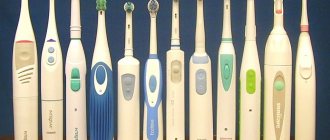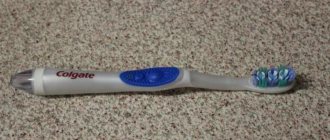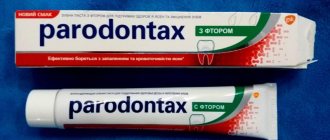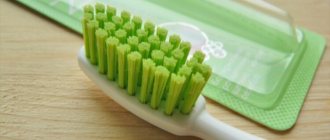A toothbrush is a device that every person has for personal use today. This is an indisputable fact and an absolutely integral attribute, without which it is quite difficult to imagine a comfortable life. Perhaps today, even every child understands that timely and systematic brushing of teeth is the key to oral health. Accordingly, it is quite obvious that the main cleaning tool - a brush - must be of high quality, in good condition, and also correctly selected.
Not only the quality of teeth cleaning, but also their immediate health and the condition of the enamel depends on the toothbrush used. Therefore, it is very important to know how to choose the right brush and what nuances to pay attention to during the selection process. But the market for such devices today is replete with not only brand names, but also types of devices, because brushes have long been not simple, but electric. And today we will try to figure out which toothbrush is better, electric or regular.
Regular toothbrush
Of course, the most common brushes today are the most common devices. Obviously, this trend is primarily observed due to the significantly lower cost compared to electric toothbrushes. However, simple brushes are presented in such an assortment that it often becomes very difficult for the average person to make a choice, because the number of parameters and characteristics inherent in brushes is almost endless. Let's understand the main aspects that you should pay attention to when choosing the best toothbrush for your individual use.
Regular product
Today, a mechanical tool is considered a budget option.
How the movements are performed with different cleaning techniques
Its work is carried out manually by a person. Using an individual instrument, it takes a lot of time to tidy up the oral cavity, rid it of pathogenic flora and remove plaque from the teeth, thereby preventing caries.
When choosing a tool, you need to pay special attention to:
- The structure of the bristles.
- The size of the working head.
Hardness level
One of the fundamental and most important parameters of toothbrushes is the level (degree) of hardness. It is important to emphasize that this factor is important, regardless of whether you are using an electric toothbrush or a regular one.
There are several main degrees of rigidity:
- Very soft. Intended for use by children with baby teeth. These brushes are also an ideal choice for adults suffering from gum or dental disease. If you have periodontitis or increased enamel sensitivity, this choice will be ideal;
- Soft. Such bristles will be an excellent assistant when used by people suffering from bleeding gums. In addition, doctors also recommend that pregnant and breastfeeding women use brushes with soft bristles. It is important to understand that you need to brush your teeth correctly, without pressing too hard;
- Medium level of hardness. The real standard, the most commonly used type of firmness, which is popular mainly among adults. If you consider your oral cavity to be completely or relatively healthy, choosing a medium-hard brush will be rational for you;
- Tough. Doctors recommend brushes with hard bristles only to those who regularly smoke or drink coffee, as well as to people exposed to heavy plaque. In other cases, use is not recommended;
- Very tough. This type of bristles on brushes is recommended by experts for cleaning removable dentures, as well as in cases of using dental braces and plates. It is these brushes that will allow you to clean the oral cavity with the highest quality and completeness.
Contraindications for use
Despite the ease of use and quality, in some situations it is better to choose a regular model. From a clinical dentistry point of view, the use of an electric brush is undesirable in the following cases:
- increased abrasion and sensitivity of teeth;
- periodontal diseases – gingivitis, periodontitis, chronic stomatitis;
- the presence of zones with disturbed mineralization (white areas);
- tartar;
- children under 3 years of age;
- wearing veneers, metal-ceramic/ceramic crowns.
Note! If you are on a limited budget, it is better to choose a regular “manual” model of good quality. As a rule, cheap options are often fakes, quickly break down and work with less efficiency.
Variety: therapeutic and prophylactic toothbrush
These brushes differ in that the bristles on them are located at different levels by default. In addition, it is also noted that such products often use villi of different hardness, this makes it possible to significantly better clean the space between the teeth, as well as get rid of plaque and food debris almost completely.
Often, therapeutic and prophylactic brushes are distinguished by the presence of rubberized or silicone inserts. They will allow you to massage your gums and tongue, as well as additionally polish the surface of your teeth.
Doctors recommend using such brushes for people with weakened gums, but a therapeutic and prophylactic brush will be the ideal choice for most people, even those who do not have problems with gums.
Age characteristics of buyers
The range of modern manufacturers includes models for people of different ages: small children from 6 months and older age groups. Taking this factor into account, hygiene items can be presented in the following variations:
- Toothbrushes for small children of preschool age. For users aged 6 months and older, silicone caps with soft bristles are designed to clean the surface of baby teeth from food debris.
- Children from 2 to 7 years old can use toothbrushes with a standard design, a small number of rows and low bristles. The main objective of such a procedure is to teach oral hygiene standards, which is why toothbrushes have a colorful design and are equipped with light and sound indicators for the end of cleaning.
- For school-age children and teenagers who have baby and permanent teeth, the brush has long bristles of varying lengths and a wide handle in bright colors.
- Toothbrushes for adults have a standard design and may differ in the degree of stiffness of the bristles.
Working principle of an electric toothbrush
Since their appearance in the 60s until today, electric brushes have come a long way. And in the form in which we have the opportunity to observe and use them today, they work according to the following principle:
- The brush handle contains a battery or battery that supplies power to the moving element.
- The moving element begins to rotate when the corresponding button is pressed.
- The rotational movements of the element are transmitted to the toothbrush head, on which there is a round tip with brush bristles.
- The tip begins to rotate.
The main advantage of such a brush is that after setting the tip in motion, the user only has to move the brush from tooth to tooth with his hand - the brush does all the rest of the work on its own.
It is important to note that there is a second type of electric brushes, which has a slightly different operating principle. We are talking about ultrasonic electric brushes that work according to the following scheme:
- A battery or battery is inserted into the handle of the brush, as well as a special sound element.
- When you press the power button, the element begins to vibrate.
- Due to the reproduced vibrations, the fibers on the nozzle begin to move.
When using ultrasonic brushes, the user needs to brush their teeth themselves, however, due to the vibrations of the brush bristles, the cleaning procedure has a higher efficiency.
Advantages and disadvantages of conventional
A regular brush is used more often than other types. Despite the fact that there are now many advanced models, many people still use it because it has its own advantages.
Benefits include :
- affordability;
- it can be purchased at any store and pharmacy;
- the ability to often replace it with a new one;
- low probability of injury to enamel and gums;
- it is easy to disinfect.
The disadvantages include the fact that the oral care procedure must last a long time . Minimum four minutes to be considered effective.
Advantages of electric toothbrushes over regular ones
Of course, electric brushes also have a whole list of obvious advantages:
- Soft plaque is removed much easier than with a regular brush and in large volumes;
- Attracts children and makes them want to systematically brush their teeth;
- Ease of use;
- Ease of transportation.
Perhaps the only drawback of an electric toothbrush is its cost, which can reach very significant levels. However, it is quite possible to find an excellent option for 15-20 dollars, which can be used for more than one year.
Bristle material
Manufacturers offer toothbrushes with synthetic or natural bristles, so products can differ in functionality, efficiency and cost:
- Synthetic bristles: the raw materials used are nylon, setron or polyurethane, which can have different hardness levels and are hygienic and easy to care for.
- Natural bristles are safe and completely environmentally friendly, so they can be expensive. Natural fibers clean the oral cavity efficiently, but can absorb harmful microorganisms, making them impractical and requiring high-quality care and regular replacement.
How to choose an electric brush
Let us also note the nuances of choosing a device such as an electric toothbrush, because for the domestic buyer such a gadget is a kind of innovation, and if you decide to use it for the first time, questions and difficulties may arise during the selection process. When purchasing, you should pay attention to the following factors:
- Power source - it can be of two types: battery and accumulator. The rechargeable option is ideal because it allows you to save on the purchase of new batteries by charging from the standard station included in the kit. It’s easy to guess that the power of battery brushes is slightly higher. And greater power directly leads to better cleaning ability;
- The technology used for moving the nozzle is the number of movements that the brush head “can” make. This can be regular rotation in one direction, in two directions, or in two directions together with pulsating movements. Such technologies are called 1-D, 2-D, and, accordingly, 3-D;
- The number of attachments included - as you know, a regular toothbrush needs to be changed periodically. Experts recommend doing this once a month. As for electric brushes, the attachments on such devices change. Therefore, the issue of having additional attachments is important;
- Additional functionality - many manufacturers are trying to expand the functionality of their devices by introducing various innovations into them. They begin with additional modes for caring for gums and teeth, and end with interfaces such as Bluetooth, for example. Of course, you have to pay for such conveniences, so such functionality can be called a small advantage, and not an urgent need.
Electrical means
Today, most people prefer to use electrical devices that can be powered by mains or batteries. Dentists also recommend using such products, since with their help you can thoroughly clean all places in the mouth that are difficult to access.
The advantages are:
- You can change the nozzles.
- Does not have a negative effect on the gums.
- Cleans enamel well.
- Massages the gums and prevents their inflammation.
- You can clean your tongue.
- Durability.
- The cleaning procedure itself is pleasant.
Sometimes an electrical device can clean by using sound waves. They are divided into:
- Ultrasonic.
- Ionic.
Do you feel nervous before visiting the dentist?YesNo
In the first case, a piezoelectric crystal is used for cleaning, which creates small vibrations of the pile. This helps to clean teeth efficiently and quickly from even the smallest particles of food and plaque. Such devices help whiten enamel, destroy microbes in the mouth, and the paste penetrates the enamel structure.
Ionic devices contain titanium dioxide in the handle. With its help, polarity is created between plaque and the tooth, which allows it to be better cleaned. With constant use of the device, the condition of the gums improves and the sensitivity of the enamel decreases.
Contraindications
In addition to their advantages, brushes have contraindications, in the presence of which their use should be abandoned. You should refrain from using them if you have the following diseases:
- Enamel aplasia.
- Caries.
- Stomatitis.
- Tooth mobility.
- Recessed gums.
- Neoplasms in the mouth.
- Periodontal disease.
To read: Sore on the lip
Those who smoke should treat such devices with caution; they can irritate the mucous membranes in the mouth, increasing the negative effects of nicotine.
Which toothbrush is better: electric or regular?
So we have come to the most important question, which is posed by many modern people who are thinking about switching to electrical devices, but have not yet made a final decision. Of course, an electric device is more comfortable to use. In addition, it is marked by a noticeably higher efficiency and higher quality work results. That is why we can safely say that an electric toothbrush is superior in its capabilities to a regular one.
However, there is one parameter in which the innovative device is inferior to the “good old” brush - price. It is quite obvious that the cost of a regular brush is much more acceptable.
As for the need to periodically replace brushes, of course, no one has canceled it. However, replacement heads for most popular electric brushes today cost about the same as a new, quality regular toothbrush. In this aspect, both types of products are equal.
In general, as we have already said, buying an advanced electric brush is a completely rational decision, but whether it makes sense to give preference to an electric toothbrush instead of a regular one is up to you to decide.
Number of rows and nature of bristle arrangement
The functionality and hygienic properties of toothbrushes are ensured by the specific arrangement of the bristles. Accordingly, there are the following groups of hygiene instruments:
- One block of bristles is typical for brushes that are used in the presence of orthodontic or orthopedic structures.
- Two rows of fibers form a hollow groove between themselves. This design is suitable as a hygienic means when using a braces system.
- Three rows of bristles – a brush with bristles arranged in three longitudinal rows provides gentle cleansing and prevents damage to gums and soft tissue.
- Four rows of fibers is the most common bristle pattern. This model of toothbrush is optimal and is often recommended by dentists for patients with healthy teeth.
Ultrasonic and ion models
In the ultrasonic model, the movements of the bristles are ensured by the action of a piezocrystal, the charge on the faces of which leads to the appearance of internal vibrations (1.6 MHz) transmitted to the bristles. Simultaneously with mechanical cleaning of the enamel, the device acts on the teeth with ultrasound.
The difference in the degree of ultrasound absorption between bone tissue and dental plaque leads to detachment and removal of plaque.
Dental care with an ultrasonic brush has the following advantages:
- removal of dental plaque and pigmentation leads to a whitening effect;
- ultrasound has an antiseptic effect on the oral cavity;
- the medicinal components of toothpaste penetrate into tissues under the influence of ultrasound;
- The device gently cleans braces, dentures and sensitive areas.
The ion device contains a titanium dioxide rod in the handle. By creating different polarities between plaque and the surface of the teeth, the brush attracts plaque and cleanses the oral cavity of germs. Its long-term use reduces gum bleeding and enamel sensitivity.
What to choose?
Dentists say that this question cannot be answered with certainty. Here it is worth taking into account the characteristics of each person and his oral cavity. The best brush is the one you use all the time. It doesn’t matter which manufacturer or the presence of any special features. The main thing is that it suits the person.
The device may be expensive and meet all the requirements. But if a certain person has certain diseases in the oral cavity, it is impossible to use a product intended for a healthy oral cavity. For example, when your gums bleed.
How to brush your teeth correctly
Standard method
The dentition is divided into 6 parts: molars on the left, right and front teeth on the upper and lower jaws.
- The teeth of the upper and lower jaws should not be connected. When cleaning them, the brush is positioned at an angle of approximately 45 degrees to the surface of the tooth.
- They begin to clean from the buccal surface of the upper jaw on the left, where they make about ten sweeping movements with the brush, then in the same way, clean the remaining teeth (about ten movements on each part).
- After this, the palatal surface of the upper teeth is cleaned according to the same pattern.
- The next step is to clean the chewing surface of the molars. This is a classic of the genre. We place the brush with the bristles towards the teeth and clean this surface with reciprocating movements. You need to make 10-15 movements on each side.
- On the lower jaw, hygiene is carried out in the same sequence, in a similar way.
- We massage the gums and clean the tongue.
Pattern of movement of a toothbrush in the oral cavity
Leonard method
The same standard method, but we perform the sweeping movements with the jaws closed. From the inner surface, of course, you will have to open your mouth. This method is more gentle on the gums.
Bass method
We position the brush at an angle of 45 degrees to the surface of the tooth, and make vibrating movements without moving the ends of the bristles. The chewing surfaces are cared for as with the standard method.
This method allows you to thoroughly clean the cervical area of the molars.
Ideally, it is necessary to combine these methods, alternate the pastes used, use dental floss, rinses and other means to get closer to the ideal state of the oral cavity. Even by performing some of the listed remedies, we will already significantly improve our health.
As you can see, there are many methods of brushing teeth, and, of course, this is not all.











